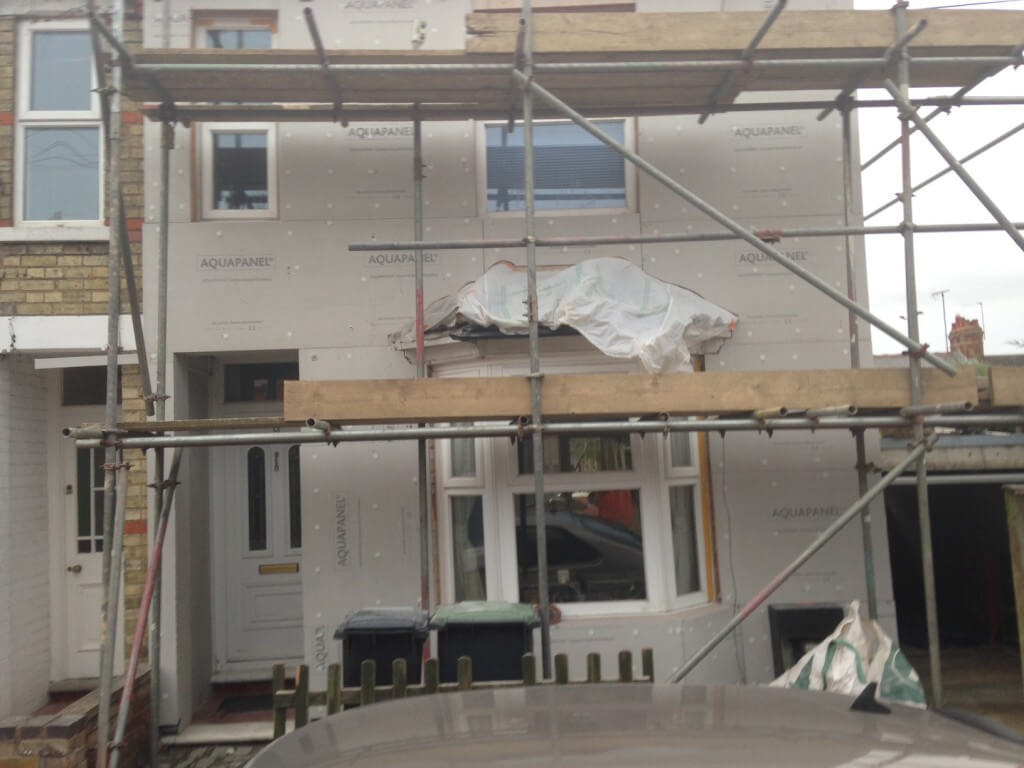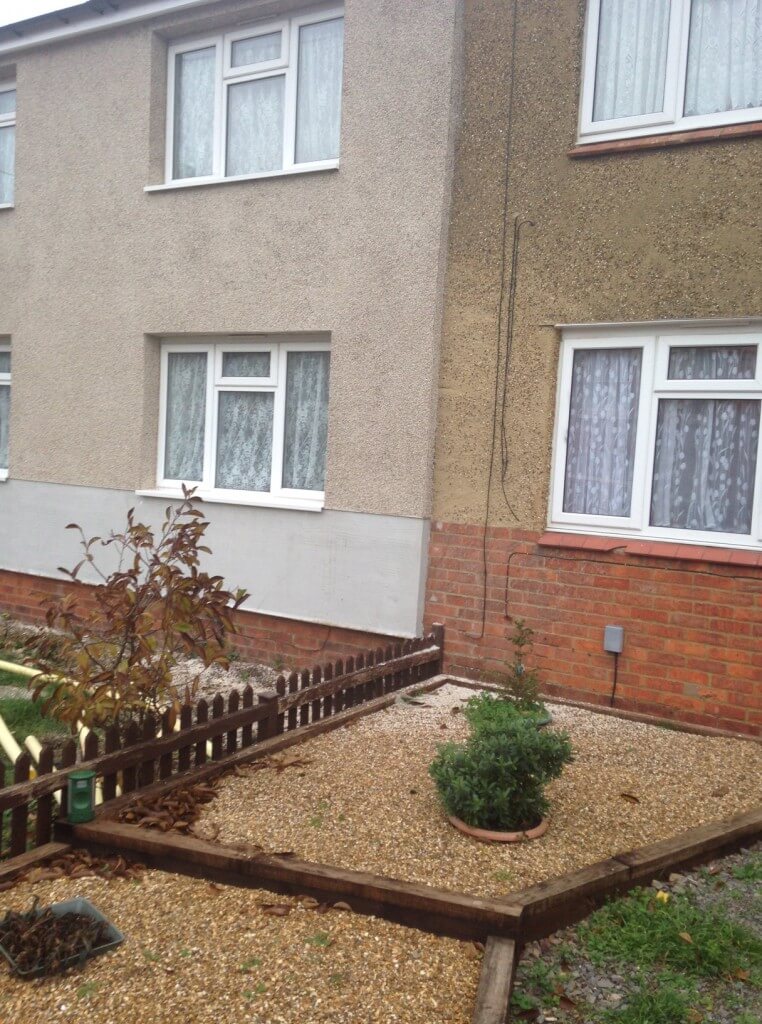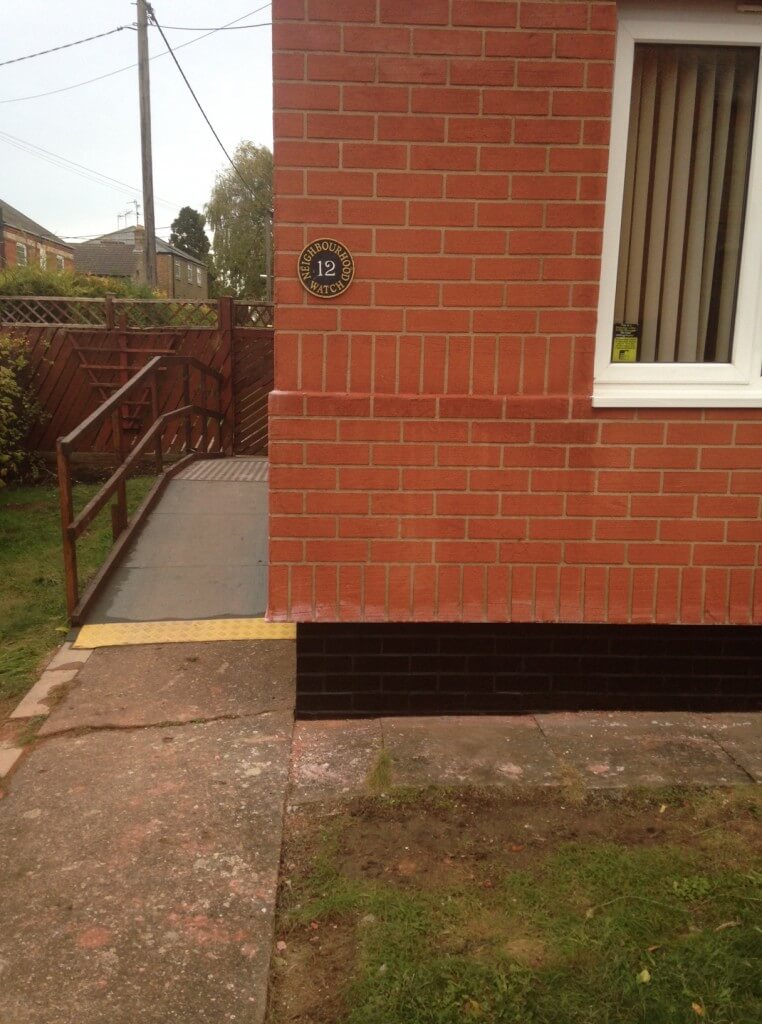In the streets around where I live, before Christmas, there were teams of workmen renovating the ‘council’ houses. Sometimes these groups had eastern European accents, sometimes they were from the foreign land of Wales, and sometimes the Northamptonshire accent was playing across the pot-holed streets of my neighbourhood.
There was quite a lot going on – new heating systems and radiators were arriving and being installed and I’m sure lots of other work was going on indoors too.
However, what caught my eye was the external insulation being added to these buildings. Below is an example of a house being ‘clad’ with its new insulation and the next two images show the width of the insulation. In some cases the insulation was finished off with some paint and pebbledash but in others with a false brickwork appearance (as in the last image). I was quite surprised to look out of the bedroom window one day and see a house with brickwork from the roof reaching only halfway down the building.
Where, as in my very late Victorian pile, there is no cavity wall, there can be no cavity wall insulation, and therefore, either internal or external insulation are the options. I was pleased to see all this work going on to increase the long-term heat efficiency of this public housing stock. It seemed like a good investment to me.
That view was reinforced as on my way back from the Post Office I got chatting to one of the residents of these houses. He told me that the house was much warmer now – one blast of heating in the morning will last through until the evening whereas pre-insulation the heating had to stay on all day.
Can somebody tell me whether it was funding for this type of work that was cut by the government before Christmas to cut energy bills? It looks like it but it’s not my area of even moderate expertise.
[registration_form]



On the fascia of it, a great idea. This technique increases the number of properties that can be made much more energy efficient. Who wouldn’t support that?
To go shamefully off topic, the second photo made me chuckle. A quintessential image of urban living. Gravel and a cat scarer!
My house started life in 1744 and the main part has non of the modern structure. The main room is cold in summer but warm in winter. The loft insulation is perfect but forget wall cavity filling with some of them 3 ft in depth. It is suggested the whole of Britain could have been lagged and filled with the money to build the present wind farms. As the wind farms are only to last 20 years what a waste of money!!
As I understand it from adverts heard on local “Ceredigion Radio” this is offered to people who fulfill certain criteria. I presume low or no wages, benefits or whatever.
It does seem to me that the best form of helping any new energy plans must be to help people use less. That has to be a priority!
When you look at the subsidies the nuclear industry will get, or the bribes to accept fracking, etc. Schemes like this make very good sense.
In case you think it can’t be done, its worth remembering that Britain has cut its landfill by 70% as a result of a determined policy of carrot and stick – a land fill tax escalator matched by investment in recycling. 49% of energy goes into heating – despite all the fuss about more obvious uses like transport, in effect it is the only game in town: with it, we can make really significant inroads, without we can achieve nothing. Halving our use of fossil fuel heat should be as feasible as the cuts achieved to landfill and looks a lot easier than any of the alternatives – why isn’t it happening ? Energy company profits perhaps and the bonanza of Government backed initiatives like new nuclear and shale gas ?
We invested in this type of insulation over a decade ago, with the same single-brick no cavity housing – it makes an amazing difference to energy use, especially as we are dependent on oil and/or electricity for heating. There has only ever been minimal local government funding for this type of work – in my area only council stock or exceptional other circumstances qualified for a grant to do it. A shame, as it is extremely effective where the no-cavity dilemma exists.
Mark, the scheme which was cut was ECO standing for Energy Companies Obligation. It is as heme to provide funding for various energy efficiency measures including insulation of ‘hard to treat’ homes such as those with solid walls.
Local Authorities have obligations to raise the energy efficiency of housing stock within their area and there are various means of funding this. If the houses you saw were actually council houses (not all authorities still own any!) it is likely the work was financed without any contribution from the tenant. For privately owned homes there are a variety of sources of funding and some LAs may offer more options than others. The main nationwide scheme currently is the ‘Green Deal’ which is not means tested because it is actually a loan not a grant. To qualify for Green Deal funding there is a so called golden rule which requires that the financial savings that will be achieved will be sufficient to finance the repayment of the loan. Previous schemes were based on grants and there is some concern that the success of the green deal may be hampered by potential debt aversity in the households most in need of support, potential impacts on house re-saleability due to the fact that the debt remains with the house if the property changes ownership a amongst other concerns.
Money invested in energy efficiency is undoubtedly money well spent both in terms of reduced environmental impact and improved well being of families.
Jonathan – that’s what I thought (I think). So the ECO scheme was cut so that we don’t all moan about our energy bills and the money that was cut would have reduced (long term) the energy use and energy bills of ‘hard to treat’ homes. That makes a lot of (non)sense doesn’t it?
Exactly. We can all use the money saved off our energy bills to buy more energy consuming gizmos. Great isn’t it?
And no thought about house martins,bats and swifts. Would have been a good opportunity to help those species with specially designed bricks and artificial nests at minimal cost.
My neighbour refused the cavity filling as he has bats in residence but then he’s old school JNCC.